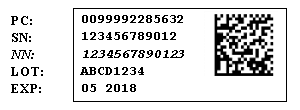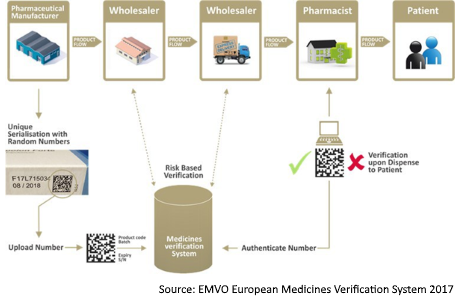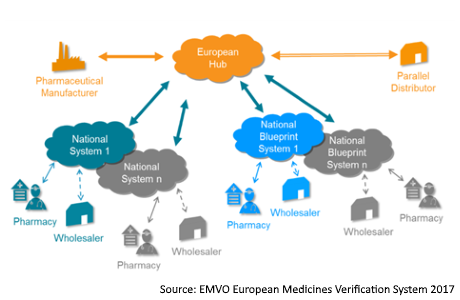
The European Union (EU) Falsified Medicines (FMD) Directive 2011/62/EU amends Directive 2001/83/EC to safeguard public health by protecting the pharmaceutical supply chain from infiltration by falsified (or counterfeit) medicines and introduces new rules to more rigorously regulate the supply chain.
The Commission Delegated Regulation (EU) 2016/161, that supplements Directive 2001/83/EC, with detailed rules for the safety features appearing on the packaging of medicinal products for human use, has now been adopted and was published in the Official Journal of the European Union on the 9th February 2016. Therefore the Delegated Regulation will come into force from the 9th February 2019 (3 years after its publication).
This Directive will impact the entire pharmaceutical supply chain from drug substance manufacturers to pharmacists dispensing medicines at point of sale.
Scope of the delegated regulation
The delegated regulation applies to the saleable units of all Prescription Only Medicines (POM) except for products on the whitelist e.g. medicinal gases and radionuclide generators. Over The Counter (OTC) drugs are generally not affected except for those on the blacklist i.e. at risk of falsification.
The delegated regulation applies to all 28 countries in the EU and also includes the EFTA countries, Switzerland, Lichtenstein, Norway and Iceland. 3 countries have received derogations to extend the compliance deadline to 9 years (2025). These are Belgium, Greece and Italy. At the time of writing, Belgium had indicated that they will not use this extension but will go-live in 2019.
The main principles of the Delegated Regulation are as follows
Safety Features
The delegated regulation calls for two distinct safety features that both need to be added to the saleable units to enhance product security. A unique identifier (UI) and a tamper evident device.
The legislation defines rules for the addition of the unique identifier, which is commonly known as serialisation, product coding and upload of data to European repositories or databases.
The legislation provides less details on the tamper evidence device other than to make its addition mandatory. The CEN standard 16679:2014 European Committee for Standardization: Packaging – “Tamper Verification Features for Medicinal Product Packaging” documents the industry best standards for Tamper Evidence devices.
In general the UI will consist of the following 4 or 5 data elements which will be printed in human readable form and also encoded in a 2D matrix.
1. Product Code (GTIN, NTIN or PPN)
2. Randomised serial number
3. National Health Reimbursement Number (If required by destination country)
4. Expiration Date.
5. Batch or lot number.

End to End Verification Model
The end-to-end serialisation model, describes the requirement for the manufacturer to print the UI on each saleable unit and then to upload that to European repositories (At one end of the supply chain). Then, at the other end, the point of dispense of the product, the UI and the tamper evidence device is verified by the pharmacist against the European repositories. If the UI is found to be verified correctly it is then dispensed and turned off in the repository.

To support this model a collection of national repositories called National Medicine Verification Systems (NMVS) will be connected together via a European Medicine Verification System (EMVS) which will act a central EU system. The manufacturers may upload data to the central EMVS when the saleable units are released for sale. The EMVS will then distribute the UI to the appropriate NMVSs. At the point of dispense the pharmacist system will then verify the UI against the NMVS in their market.

Verification of high risk practices within the supply chain
In addition to the verification of the UI at the point of dispense, the delegated regulation also requires certain high risk (of falsification) processes, which need to be enhanced.
For example, product returned to a wholesaler for re-sale must, in future, be verified to be still valid in the European repositories or product received from a source which is not designated by the manufacturer must also be verified.
Secondly, product which is not destined for sale in the EU must be verified and turned off in the European repositories. Examples include, samples to regulatory agencies, EU product shipped to markets outside the EU, product for destruction etc.
In these instances, the verification process must include checking both the UI and the tamper evidence device.
Regulatory information
Unfortunately in Europe our pharmaceutical processes are not always harmonised. This is true also for FMD serialisation requirements. Each market is free to interpret the delegated regulations and how to implement them.
For example, many markets already have existing pharmaceutical item number systems, Germany, Austria, Belgium, Portugal, Nordics, to name but a few, which are used extensively within the supply chain in the market. As markets decide how to implement the FMD serialisation model in their local markets the usage of these product codes will need to change. It is therefore very important that any changes in these areas are communicated well in advance, so that supply chain partners can adapt their system to meet the local requirements.
Multi-market packs
Multi market packs are manufactured with the intent to be sold in several markets. The European repositories have been designed to support these packs and as the individual market decide on the implementation rules we may find packs with several product codes on them potentially using the NN (National Reimbursement Number) for identification in one market and the PC (Global Trade Item Number) in another market.
Another consideration for multi-market packs would be if a EU market (such as Cyprus), shares packs with Greece, when the packs are released the UIs will be uploaded to EMVS, but when the packs are shipped to Greece they must the turned off in the EMVS as until 2025 they will be outside of the EMVS system. This will also apply to Italy.
EMVS upgrade imminent
This summer the EMVS implemented a system upgrade to bring on line new features and enhancements. One of the main enhancements will be the expansion of the product master data to be uploaded. The goal is to align the product master data with the different information needs for multiple markets presentations and with the European Identification of Medicinal Products project (IDMP). It is highly recommended that once this upgrade has been completed, manufacturers complete the on-boarding process, collect master data and upload this product master data so that they are very familiar with the process as the FMD deadline approaches.
Eamonn O’Mathuna is a manufacturing systems consultant with ESP with particular expertise in MES, automation and serialisation. He has over 30 years’ experience as a manufacturing systems expert in big pharma with over 10 years niche focus on serialisation having played a key role as technical lead on a 2007 site roll out for a multinational biopharmaceutical company. Since joining ESP in 2012, Eamonn has played a pivotal role on several manufacturing site and supply chain serialisation projects.
©
SecuringIndustry.com
 | back to top
| back to top








